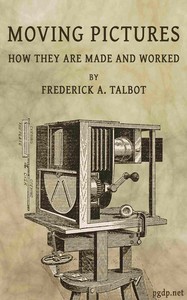Moving Pictures: How They Are Made and Worked by Frederick Arthur Ambrose Talbot
"Moving Pictures: How They Are Made and Worked" by Frederick Arthur Ambrose Talbot is a scientific publication written in the early 20th century. The book explores the process and technology behind the creation of moving pictures, detailing advancements in photography and the intricate work performed by various pioneers in the field. It serves as both a historical account and an informative guide to understanding the mechanics and artistry involved in motion photography.
The opening of this work introduces the concept of animated photography and the challenges overcome by early inventors in capturing movement. Talbot discusses the transition from lengthy exposure times that made capturing motion nearly impossible to the development of instantaneous photography, which paved the way for motion pictures. He emphasizes the significance of visual persistence—the way the human brain perceives rapid sequences of images as continuous motion—and outlines the inventions and experimentations that led to the inception of moving pictures, setting the stage for the later detailed chapters on the technical aspects of film production and projection. (This is an automatically generated summary.)
Read now or download (free!)
| Choose how to read this book | Url | Size | ||||
|---|---|---|---|---|---|---|
| Read online (web) | https://www.gutenberg.org/ebooks/67972.html.images | 873 kB | ||||
| EPUB3 (E-readers incl. Send-to-Kindle) | https://www.gutenberg.org/ebooks/67972.epub3.images | 28.7 MB | ||||
| EPUB (older E-readers) | https://www.gutenberg.org/ebooks/67972.epub.images | 28.7 MB | ||||
| EPUB (no images, older E-readers) | https://www.gutenberg.org/ebooks/67972.epub.noimages | 540 kB | ||||
| Kindle | https://www.gutenberg.org/ebooks/67972.kf8.images | 45.3 MB | ||||
| older Kindles | https://www.gutenberg.org/ebooks/67972.kindle.images | 45.3 MB | ||||
| Plain Text UTF-8 | https://www.gutenberg.org/ebooks/67972.txt.utf-8 | 728 kB | ||||
| Download HTML (zip) | https://www.gutenberg.org/cache/epub/67972/pg67972-h.zip | 35.9 MB | ||||
| There may be more files related to this item. | ||||||
About this eBook
| Author | Talbot, Frederick Arthur Ambrose, 1880-1924 |
|---|---|
| Title | Moving Pictures: How They Are Made and Worked |
| Original Publication | United States: J. B. Lippincott,1914. |
| Note | Reading ease score: 56.1 (10th to 12th grade). Somewhat difficult to read. |
| Credits | deaurider, Charlie Howard, and the Online Distributed Proofreading Team at https://www.pgdp.net (This file was produced from images generously made available by The Internet Archive) |
| Language | English |
| LoC Class | PN: Language and Literatures: Literature: General, Criticism, Collections |
| Subject | Motion pictures |
| Category | Text |
| EBook-No. | 67972 |
| Release Date | May 2, 2022 |
| Copyright Status | Public domain in the USA. |
| Downloads | 205 downloads in the last 30 days. |
| Project Gutenberg eBooks are always free! | |

